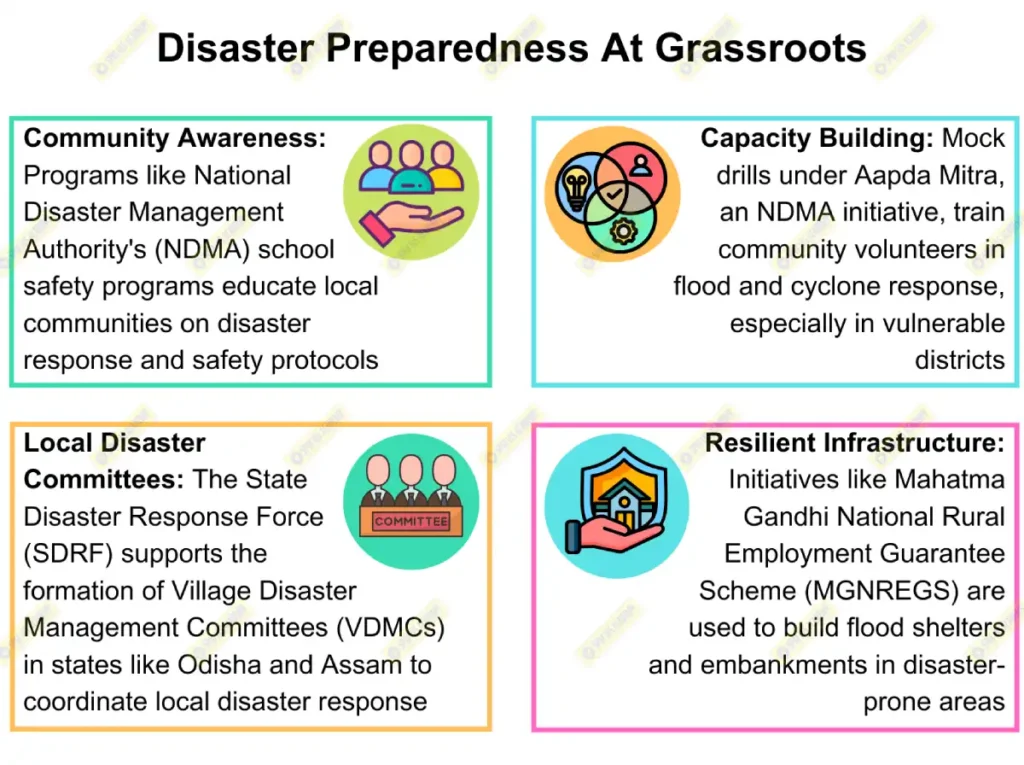Panchayati Raj Institutions (PRIs) play a pivotal role in rural governance, making them well-suited to lead efforts in earthquake preparedness at the grassroots level. Their proximity to local communities, ability to mobilize local resources, and capacity to foster Jan Bhagidari (people’s participation) are key to making disaster management efforts more effective and inclusive. The Sendai Framework for Disaster Risk Reduction (2015–2030) and various national initiatives emphasize community-based approaches to disaster preparedness, making PRIs crucial in the context of earthquake preparedness.
Role of PRIs in Earthquake Preparedness:
A. Awareness Generation and Capacity Building:
- Community Education: PRIs can organize awareness campaigns on earthquake risks, safety measures, and emergency protocols. In line with the Jan Bhagidari principle, PRIs can actively involve villagers in safety drills and spread awareness through local institutions like schools and health centers.
- Training Programs: PRIs can collaborate with the National Disaster Management Authority (NDMA) and state disaster management authorities to conduct first-aid training and earthquake drills. Such efforts help create a culture of preparedness, ensuring that the community knows how to respond during an earthquake.

B. Disaster-Resilient Infrastructure Development:
- Promotion of Earthquake-Resistant Construction: PRIs can work with local engineers to ensure that earthquake-resistant building techniques are followed, especially in public buildings like schools, panchayat offices, and health centers. Government programs like PMAY-G (Pradhan Mantri Awas Yojana – Gramin) can be leveraged to encourage resilient housing.
- Retrofitting Existing Structures: PRIs can promote the retrofitting of older structures, in line with National Building Code guidelines, to make them safer during earthquakes. By involving local communities in decision-making, PRIs can ensure these efforts align with local needs.
C. Preparedness Planning and Risk Mapping:
- Village Disaster Management Plans (VDMPs): PRIs are crucial in preparing VDMPs with detailed information on hazard mapping, evacuation routes, and safe shelters. The NITI Aayog’s Disaster Management Plan (2018) stresses the importance of community-led preparedness plans, where PRIs can lead the charge.
- Risk Mapping: PRIs, with local knowledge, can identify vulnerable areas (e.g., regions prone to landslides or soil liquefaction during earthquakes) and ensure these areas are prioritized in preparedness efforts.
D. Communication and Coordination:
- Early Warning Systems: PRIs can play a critical role in disseminating early warnings and alerts to remote areas. Collaborating with state disaster management authorities, PRIs can ensure that early warning systems reach all sections of the community, including marginalized groups.
- Coordination with Government Agencies: PRIs act as a crucial link between the community and district administration. In line with the Bottom-Up Approach advocated by the Sendai Framework, PRIs ensure that disaster response is localized and responsive to community needs.
E. Post-Disaster Relief and Rehabilitation:
- Relief Distribution: PRIs can coordinate local efforts to distribute relief materials like food, water, and medical supplies. Their local networks ensure that resources reach the most affected in the shortest time possible.
- Damage Assessment and Reconstruction: In collaboration with district-level authorities, PRIs can conduct initial damage assessments and help prioritize rehabilitation efforts. They can also oversee reconstruction, ensuring community involvement and compliance with disaster-resilient practices.
F. Encouraging Community Participation (Jan Bhagidari):
- Mobilizing Local Participation: PRIs can actively involve citizens in all stages of earthquake preparedness, including risk assessment, planning, and mock drills. By fostering Jan Bhagidari, PRIs ensure that disaster preparedness becomes a collective effort, enhancing social cohesion and resilience.
- Self-Help Groups (SHGs): PRIs can collaborate with local SHGs and women’s groups to build capacity in disaster preparedness. Engaging SHGs aligns with initiatives like the DAY-NRLM (Deendayal Antyodaya Yojana – National Rural Livelihood Mission), empowering communities to be better prepared.
G. Resource Mobilization and Disaster Financing:
- Accessing Disaster Funds: PRIs can access disaster management funds through programs like the State Disaster Response Fund (SDRF) and the National Disaster Response Fund (NDRF) to enhance earthquake preparedness at the village level. This ensures that local resources are readily available when needed.
- Promoting Disaster Insurance: PRIs can promote disaster insurance schemes for houses, crops, and livestock to minimize financial burdens post-disaster. They can encourage participation in schemes like the Pradhan Mantri Fasal Bima Yojana (PMFBY) to safeguard livelihoods from earthquake-related damage.
H. Leveraging Government Initiatives:
- Pradhan Mantri Gram Sadak Yojana (PMGSY): PRIs can leverage PMGSY to ensure that roads and other critical infrastructure are built using disaster-resilient designs, making transportation and evacuation smoother during emergencies.
- Mahatma Gandhi National Rural Employment Guarantee Scheme (MGNREGS): PRIs can utilize MGNREGS funds for building and maintaining infrastructure such as roads and community centers that can double up as shelters during an earthquake, ensuring that preparedness infrastructure is built sustainably.
Panchayati Raj Institutions (PRIs) can serve as the backbone of earthquake preparedness in rural India by leveraging their local knowledge, promoting Jan Bhagidari, and ensuring efficient resource mobilization. By focusing on awareness generation, disaster-resilient infrastructure, village-level disaster management plans, and community participation, PRIs can foster a culture of preparedness and resilience. Effective collaboration with state and national disaster management agencies, alongside the use of government schemes like PMAY-G and MGNREGS, can further enhance the role of PRIs in earthquake preparedness.












